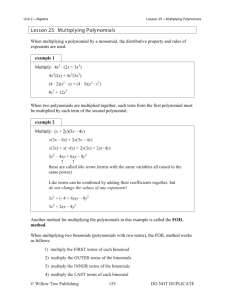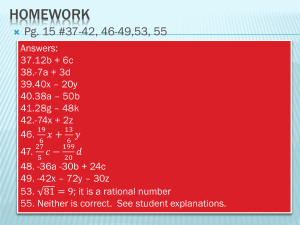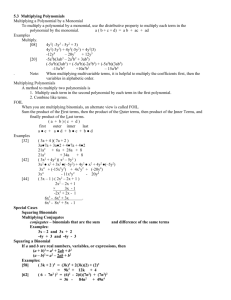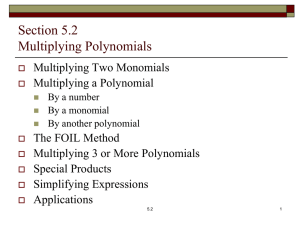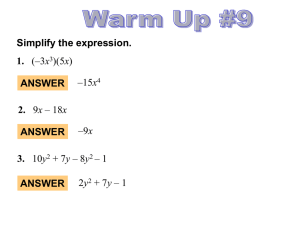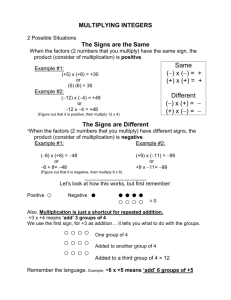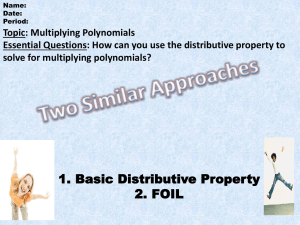Multiplying Polynomials
advertisement
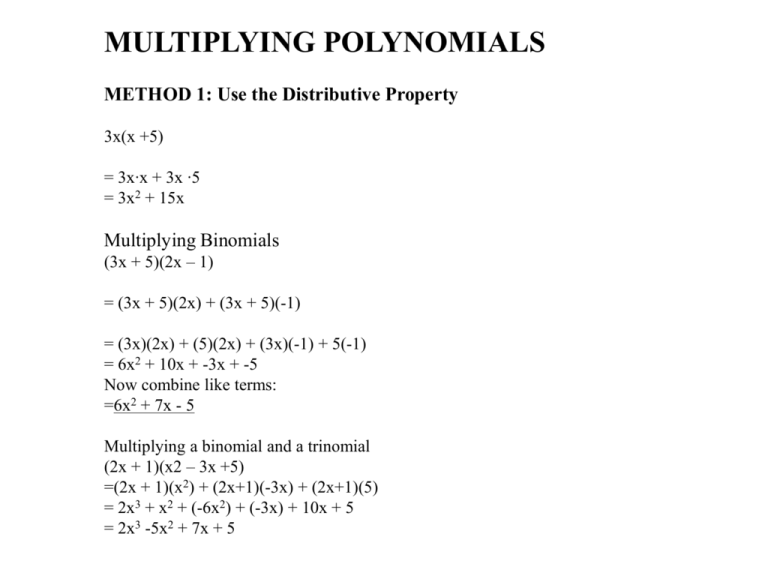
MULTIPLYING POLYNOMIALS METHOD 1: Use the Distributive Property 3x(x +5) = 3x∙x + 3x ∙5 = 3x2 + 15x Multiplying Binomials (3x + 5)(2x – 1) = (3x + 5)(2x) + (3x + 5)(-1) = (3x)(2x) + (5)(2x) + (3x)(-1) + 5(-1) = 6x2 + 10x + -3x + -5 Now combine like terms: =6x2 + 7x - 5 Multiplying a binomial and a trinomial (2x + 1)(x2 – 3x +5) =(2x + 1)(x2) + (2x+1)(-3x) + (2x+1)(5) = 2x3 + x2 + (-6x2) + (-3x) + 10x + 5 = 2x3 -5x2 + 7x + 5 Multiplying Larger Polynomials Using the Distributive Property The Vertical Method of multiplication is sometimes more efficient. (3x + 2)(x2- x+4) x2 x 4 3x 2 2x2 2x 8 3 x 3 3 x 2 12 x 3 x 3 x 2 10 x 8 Multiply : x 2 2 x 7 x 2 x2 2x 7 x2 Just as you would in multiplying whole numbers, put the larger polynomial (the one with more terms) on top and the smaller polynomial on the bottom. Multiply every term in the larger polynomial by 2 (the last term in the other polynomial). Then on the next line multiply every term in the larger polynomial by the next term in the smaller polynomial (3x). Make sure to line up like terms. METHOD 2: FOIL (First, Outer, Inner, Last) - This only works for multilying binomials (polynomials with only 2 terms) (3x + 5)(2x – 1) The First terms in each of these binomials are 3x and 2x. The Outer terms are the ones on the “outsides” of the binomials, 3x and -1. The Inner terms are the ones in the middle, 5 and 2x. The Last terms are the second terms of each binomial, 5 and -1. FOIL = (3x)(2x) + (3x)(-1) + (5)(2x) + 5(-1) = 6x2 + -3x + 10x + -5 Now combine like terms: (3x + 5)(2x – 1) =6x2 + 7x - 5 METHOD 3: Box Method. This method works for every problem! Here’s how you do it. Multiply (3x – 5)(5x + 2) Draw a box. Write a polynomial on the top and side of a box. It does not matter which goes where. This will be modeled in the next problem along with FOIL. 3x 5x +2 -5 3) Multiply (3x - 5)(5x + 2) First terms: 15x2 Outer terms: +6x Inner terms: -25x Last terms: -10 Combine like terms. 15x2 - 19x – 10 3x 5x -5 15x2 -25x +2 +6x -10 You have 3 techniques. Pick the one you like the best! 4) Multiply (7p - 2)(3p - 4) First terms: 21p2 Outer terms: -28p Inner terms: -6p Last terms: +8 Combine like terms. 21p2 – 34p + 8 7p -2 3p 21p -6p -4 28p +8 2 5) Multiply (2x - 5)(x2 - 5x + 4) You cannot use FOIL because they are not BOTH binomials. You must use the distributive property or box method. x2 -5x +4 2x 2x3 -10x2 +8x -5 -5x2 +25x -20 Almost done! Go to the next slide! 5) Multiply (2x - 5)(x2 - 5x + 4) Combine like terms! x2 -5x +4 2x 2x3 -10x2 +8x -5 -5x2 +25x -20 2x3 – 15x2 + 33x - 20 Special Products of Binomials CASE 1: The Sum and Difference of Two Terms (a + b)(a - b)=a2 – b2 FOIL: a2 + ab – ab – b2 The inner terms and outer terms will always cancel each other out, so you are left with: a2 – b2 Examples: (x + 2)(x – 2) = x2 +(2)(-2) = x2 – 4 (2x + 3)(2x -3) = (2x)2 +(3)(-3) = 4x2 – 9 CASE 2: The Square of a Binomial (a + b)2 = a2 + 2ab + b2 Examples: (x + 3)2 = x2 + 2(3)(x) + 32 = x2 + 6x + 9 (3x – 2)2 = (3x)2 + 2(3x)(-2) + (-2)2 = 9x2 -12x + 4 YOU TRY: (6x – y)2
